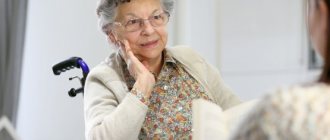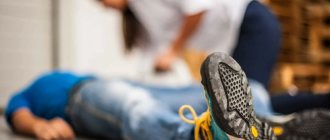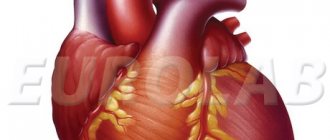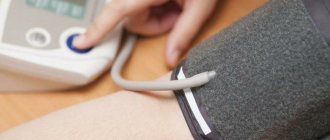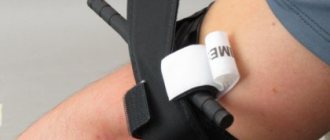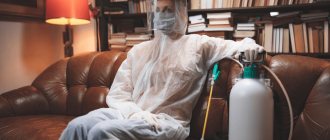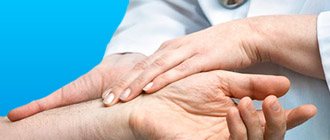First aid for stroke
A stroke is an acute disorder of cerebral circulation caused by narrowing or blockage of blood vessels (ischemic stroke) or hemorrhage due to a ruptured vessel (hemorrhagic stroke).
In Russia, about 450,000 strokes are recorded annually. People of all ages are susceptible to this disease, but older people over 65 are especially susceptible.
A stroke occurs suddenly, often without preliminary symptoms, at any time of the day. A person’s life at this moment depends on who is nearby and how quickly help is provided, because the victim’s death is only 3-6 hours away.
Signs of stroke in men and women may have distinctive features, but the main ones are characteristic of both sexes:
- sudden weakness and numbness in an arm or leg on one side;
- sudden numbness of the lip or half of the face;
- sudden clouding of consciousness, speech impairment and misunderstanding of the interlocutor’s speech;
- sudden feeling of double vision, blurred vision;
- sudden disturbance in gait, loss of balance and coordination;
- sudden headache or dizziness;
If you suspect that someone near you has similar signs, but are not sure, do a test, which for ease of remembering is called “USP” - smile, talk, raise. Ask the person to do these three things. If the person is unable to smile, say their name clearly, and raise both hands
Call an ambulance!
First aid for a stroke at home before the ambulance arrives consists of the following steps:
- Place the patient on a horizontal surface and raise his head and shoulders;
- loosen your collar, unfasten your belts and buttons, open your windows; in older people, dentures should be removed;
- turn him on his right side and place a basin next to him in case of vomiting;
- measure your blood pressure, if it is higher than 140 to 90, give you medications that lower your blood pressure;
In Russia, the number of strokes increases in the summer, as a rule, this is a consequence of active work in summer cottages. The risk of stroke increases especially among pensioners, who, after the calm of winter at home, are happy to be active in the garden.
Neurologists have developed recommendations for this category of people:
- before leaving for the dacha, find out its exact address and how to call an ambulance there;
- take a tonometer with you and measure your blood pressure daily;
- make sure your mobile phone is charging, it should always be operational;
- take with you a supply of medicines for the entire season;
- do not work under the scorching sun, the best time for active work is either before 10.00 or after 15.00;
- work while sitting on a bench, and never upside down;
- Always wear a hat and generally try to stay in the shade.
Signs of stroke in women and men
In terms of incidence, stroke remains second only to cancer. In addition, it is a common cause of disability.
A little about the terms:
- A stroke is a sudden disruption of blood flow in the brain or spinal cord.
- A microstroke (correctly, a transient ischemic attack) is a disruption of blood flow due to a spasm or a general decrease in blood flow, lasting no more than three hours.
On the first day, it is impossible to distinguish between the symptoms of a stroke and a microstroke without special examinations.
There are no fundamental differences in the signs of stroke in women and men. Manifestations usually appear suddenly.
The main first signs of a stroke are as follows:
- weakness or awkwardness in an arm or leg on one side;
- numbness in the limbs on one side;
- impaired speech understanding;
- difficulty pronouncing words and composing sentences;
- dizziness;
- loss of balance;
- unsteady gait;
- difficulties in performing habitual movements (lighting a match, picking up a cup);
- headache of varying intensity;
- seizures;
- numbness of half the face, lip or tongue;
- smoothing the nasolabial fold on one side;
- loss of consciousness;
- vomit.
A sign of the onset of a stroke may also be one of these symptoms.
External signs of a stroke can vary. If you suspect a violation of cerebral blood flow, you can ask the person to perform a few simple tests:
- smile;
- close your eyes tightly;
- stick out tongue;
- say a simple tongue twister (Karl stole corals from Clara);
- extend your arms in front of you;
- take several steps along one line.
If any test shows abnormalities, even doubtful ones, you should seek medical help immediately. Early signs of a stroke can be vague, and only a full examination reveals the scale of the problem.
How to recognize a stroke in time?
You already know what to do in case of a stroke (the 4-hour rule). Time is of the essence to effectively help a victim. But how to recognize a vascular accident in time? This can be done based on the following main criteria:
- Facial expression. The victim cannot smile; when smiling, there is asymmetry (one corner of the mouth does not rise).
- Hand movements. The victim cannot raise and hold both arms above his head (one limb spontaneously drops).
- Speech disorders. Speech becomes slurred and unintelligible. The victim cannot pronounce words and swallows letters.
Not all symptoms of a stroke always appear. Violations may be isolated. You should seek medical help if any warning signs appear that were not previously characteristic of the person.
And you should definitely find out when the violations appeared. Be attentive to yourself and your loved ones. And don’t worry, the ACMD-Medox Medical Center will certainly help you!
Contact phone: (044) 393-09-33
First aid effectiveness and prognosis
According to statistics, correctly provided emergency care for stroke patients with delivery to a medical facility within the first three hours:
- saves the lives of 50–60% of patients with severe massive strokes;
- in 75–90% it allows people with minor strokes to fully recover;
- improves the recovery abilities of brain cells by 60–70% in case of any stroke (better in case of ischemic stroke).
Remember that a stroke can happen to anyone at any time. Get ready to take the first step to help fight this disease!
Detailed description of all emergency steps
Each activity that includes first aid for a stroke requires proper execution. It is very important to adhere to subtleties, since any “little detail” can be fatal.
No fuss
No matter how serious the patient’s condition, do not panic or fuss. You must act quickly, harmoniously and consistently. Fear, fuss, haste, and unnecessary movements lengthen the time it takes to provide assistance.
Reassure the patient
Every conscious person with a stroke is definitely worried. After all, this disease is sudden, so the body’s stress reaction cannot be avoided. Anxiety will aggravate the condition of the brain. Try to reassure the patient, convince him that everything is not so scary, this happens and doctors will definitely help solve the problem.
Call an ambulance
Calling an ambulance is the first priority. Even the slightest suspicion of a stroke is an indication to call. Specialists will better understand the situation.
Call 103, tell the dispatcher what happened and where. It will take no more than a minute. While the ambulance is on the way, you will provide emergency care.
Assess your general condition
First of all, pay attention to:
- Consciousness: its complete absence or any degree of confusion (lethargy, drowsiness) is a sign of a severe stroke. Mild forms are not accompanied by impaired consciousness.
- Breathing: it may not be impaired, or it may be absent, intermittent, noisy, frequent or rare. Artificial respiration can be performed only in the complete absence of respiratory movements.
- Pulse and heartbeat: they can be clearly audible, rapid, arrhythmic or weakened. But only if they are not detected at all, you can do indirect cardiac massage.
Assess the patient's condition and determine the need for cardiopulmonary resuscitation
Identify the signs of a stroke
Stroke patients may have:
- severe headache, dizziness (ask what is bothering the person);
- short-term or persistent loss of consciousness;
- distorted face (ask him to smile, bare his teeth, stick out his tongue);
- impaired or lack of speech (ask to say something);
- weakness, numbness of the arms and legs on one side, or their complete immobility (ask them to raise their arms in front of you);
- visual impairment;
- impaired coordination of movements.
Lack of consciousness or any combination of these signs is a high probability of a stroke.
Correct position of the patient
Regardless of whether the consciousness and general condition of a stroke patient is impaired or not, he needs rest. Any movements, especially independent movement, are strictly prohibited. The position could be:
- On the back with the head and chest raised - with preserved consciousness.
- Horizontally on the side with the head turned to one side - in the absence of consciousness, vomiting, convulsions.
Correct position of the patient in the absence of consciousness
- Horizontally on the back with the head slightly thrown back or turned to the side - during transportation and resuscitation measures.
It is forbidden to turn a person on his stomach or lower his head below his body position!
If there are cramps
Convulsive syndrome in the form of severe tension of the whole body or periodic twitching of the limbs is a sign of a severe stroke. What to do with the patient in this case:
- Lay on your side with your head turned to prevent saliva and vomit from entering your respiratory tract.
- If you can, place any object wrapped in cloth between the jaws. It is rarely possible to do this, so do not make much effort - it will do more harm than good. Do not try to push the jaws apart with your fingers - this is impossible. Better grab the corners of the lower jaw, try to bring it forward. Do not insert your fingers into the patient's mouth (risk of injury and loss of a finger).
- Keep the patient in this position until the convulsions end. Be prepared for the possibility that they may happen again.
On the importance of the circumstances of the disease
If possible, find out exactly how the person got sick. This is very important, since some symptoms of stroke can also be observed in other diseases:
- traumatic brain injury;
- diabetes mellitus;
- brain tumors;
- poisoning with alcohol or other toxic substances.
Resuscitation: conditions and rules
Advertising:
An extremely severe stroke, affecting vital centers, or accompanied by severe cerebral edema, occurs with signs of clinical death:
- complete lack of breathing;
- dilation of the pupils of both eyes (if only one pupil is dilated - a sign of a stroke or hemorrhage in the hemisphere on the affected side);
- complete absence of cardiac activity.
Follow these steps:
- Place the person on their back on a hard surface.
- Turn your head to the side, use your fingers to free the oral cavity from mucus and foreign objects (dentures, blood clots).
- Throw your head back well.
- Grab the corners of the lower jaw with 2–5 fingers of both hands, pushing it forward, while using your thumbs to slightly open the patient’s mouth.
- Artificial respiration: cover the patient’s lips with any cloth, and, pressing your lips tightly, take two deep breaths (mouth-to-mouth method).
- Heart massage: Place your right hand on top of your left (or vice versa), interlocking your fingers. Applying your lower palm to the junction of the lower and middle parts of the patient's sternum, apply pressure to the chest (about 100 per minute). Every 30 movements should alternate with 2 breaths of artificial respiration.
What medications can be given for a stroke?
If an ambulance is called immediately after a stroke occurs, it is not recommended to give the patient any medications on your own. If delivery to the hospital is delayed, the following drugs (preferably in the form of intravenous injections) help support brain cells at home:
- Piracetam, Thiocetam, Nootropil;
- Actovegin, Ceraxon, Cortexin;
- Furosemide, Lasix;
- L-lysine escinate.
Self-help for stroke
The ability to help yourself with a stroke is limited. In 80–85% of cases, a stroke occurs suddenly, manifested by a sharp deterioration in condition or loss of consciousness. Therefore, patients cannot help themselves. If you experience stroke-like symptoms:
- take a horizontal position with the head end raised;
- tell someone you feel bad;
- call an ambulance (103);
- adhere to strict bed rest, do not worry and do not move excessively;
- release the chest and neck from constricting objects.
Helping yourself if you have a stroke
If the stroke is hemorrhagic
Symptoms that speak in favor of hemorrhagic stroke:
- arose abruptly at the height of physical or psycho-emotional stress;
- there is no consciousness;
- have convulsions;
- the neck muscles are tense, it is impossible to bend the head;
- high blood pressure.
In addition to standard care, such patients need:
- The position is strictly with the head end elevated (except for convulsions or resuscitation).
- Applying an ice pack to the head (preferably to the half in which hemorrhage is suspected - opposite to the immobilized tense limbs).
Features of providing assistance on the street
If a stroke occurs on the street, first aid has the following features:
- Involve several people to help. Organize the actions of each of them, clearly distributing responsibilities (someone calls an ambulance, and someone assesses the general condition, etc.).
- Having placed the patient in the desired position, free the neck and chest to make it easier for him to breathe (remove the tie, unfasten the buttons, loosen the belt).
- Wrap up the limbs, cover the person with warm clothes (in cold weather), massage and rub them.
- If you have a mobile phone or contacts with relatives, inform them about what happened.
Caring for a person who is bedridden after a stroke
No matter how severe the blow, initial recovery will require bed rest. Often after an ischemic stroke, paralysis occurs, which means that care needs to be much more careful. First of all, a recumbent person should not be allowed to remain in one position for a long time: to do this, he needs to be turned over at certain intervals (it is optimal to change the position after 3-4 hours), they help to perform therapeutic exercises that speed up recovery. Fixed limbs are ensured in the correct position: not in a canopy, but supported by bolsters and garters.
An important rule: the paralyzed arm should lie in an extended position with straight fingers; the correct position can be achieved by placing the limb on a nearby stool with a pillow on it.
To maintain proper blood circulation, the knees are placed on a bolster and the feet are placed on a stand. In case of a unilateral stroke, it is recommended to maintain the same position on the healthy and diseased leg.
If an elderly relative is lying on his healthy side, then you need to bend the paralyzed limbs at the joints and place cushions under them.
Home care for patients after a stroke who lie on the paralyzed side has its own peculiarity. The person's head should be slightly tilted down. The paralyzed arm is straightened and placed at an angle of 90 degrees to the torso. Be sure to turn it palm up. The healthy arm is pulled back.

